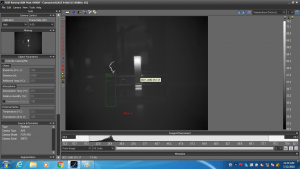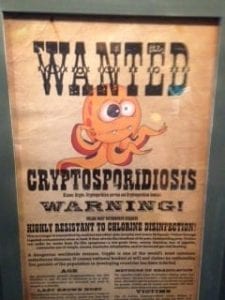What an amazing summer this has been! I’ve truly enjoyed my internship here at Rice with the RET program. Everone has been so kind and helpful. I’ve learned more than I could have imagined– both about science and about being a learner. Although I didn’t have much time off for the summer, I still have that enthusiastic feeling about soon returning to school with my students. I can’t wait to share my experience with them and my fellow teachers.
Week 6 started off with our poster feedback sessions. It was incredibly helpful! After talking out my story and referring to my poster on the big screen TV, I saw how I definitely needed to rearrange my visuals and blocks of text so that I could better support my research story through the poster. I’m looking forward to presenting at the Symposium tomorrow and especially seeing everyone’s posters printed out!
This week I went on another field trip. My longtime friend (and former neighbor), Johanna Anderson, works at Suez Water Technologies and Solutions (formerly GE). They are located in the Woodlands, Tx not far from my home in Magnolia, Tx. I called her up and explained what I’ve been doing at Rice and asked her to tell me about what she does at Suez. So much of what she does when testing water is exactly what we do (but on a much smaller scale) here in the Torres Lab. She got permission for me to visit, and this past Tuesday I took a tour of the facility. Having learned so much about the nitrogen cycle and nutrients in wastewater, it was a fabulous experience to tour the labs. I was able to understand what she was talking about when she explained what all the machines did, and even better I was able to ask lots of questions! It truly helped me to see how the research I’ve been doing on a daily basis fits into the “real world” outside of the lab. I made a powerpoint presentation with embedded links of equipment and testing methods explanations and videos. Here’s the link to accesses if you happen to teach anything that would require your students to learn about water treatment:
https://drive.google.com/file/d/1hOHOUocR-6NgIb7O2sr7s-bJdTyV6enY/view?usp=sharing

Wednesday, our entire group (Carrie Masiello, Mark Torres, Solana Buchanan, myself) met for the last time during my internship. Solana is an amazing undergraduate student (a rising junior). Several times she and I gathered water samples from the bayous together. She presented all of her data and research to Mark and Carrie in regards to all of the samples we’ve collected this summer. In the meeting, I was able to talk about my poster one last time and present all of the research I have participated in with our group this summer. It was a great way to review before the symposium and a good recap of my summer activities.

I’m kind of sad to say goodbye to my group. They are an outstanding group of scientists and educators. I feel we became friends as well so I will miss seeing them around. I feel extremely lucky to have worked with them these last six weeks. And not pictured is Loredana Sucia. She is a graduate student working in Earth Sciences. I must also thank her for the many hours she spent with me, teaching me how to use Excel and interpret my data. She’s amazing!

I would say that’s all folks, but I’m looking forward to seeing my fellow Rice RET teachers in the fall as we meet again to prepare our lessons for submission. Good luck to everyone on Friday with the poster presentations!











